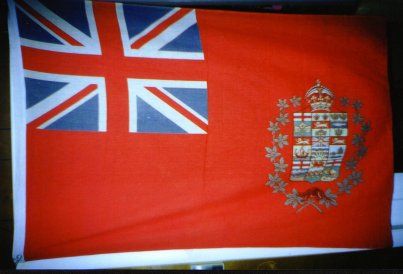


| Why did Harry emigrate? |
 |
 |
 |
|
Above, the flags of Canada, South Africa, and the United States Through the lives of our Wighton ancestors, we have seen the speed and depth with which Scotland entered its industrial age. Although that change from an agrarian society to an industrialized society had its disadvantages of unsanitary conditions in slum cities and poverty for many, the Victorian era brought the United Kingdom to unheard of heights in the world economic and military order. A significant contributor to that advance was the availability of cheap natural resources from the colonies. England controlled the shipping lanes throughout the world and raw materials from the colonies made their steady way to the factories and mills in England and Scotland. As a result, the UK's economy continued to grow, especially when compared to that of other countries who incurred much higher costs for their raw materials The people of the UK contributed a second, perhaps even more important, ingredient to economic success. Just as we see today with Brazil, China, and India's 21st century march into industrialization, the availability of cheap labour is paramount for success. And Scotland had cheap labour in abundance. In Harry's Scotland, if you didn't have the education and professional jobs of the growing middle class, Scottish citizens still worked for a pittance in terrible working conditions. In 1900 when Harry graduated, a handful of powerful families, all clearly visible through their titled names and massive family estates, owned the best properties and controlled Scotland's political, legal, and economic frameworks and future. Even in the face of electoral reforms which expanded the size of the electorate, the Scottish nobility managed to ensure that political power was skewed disproportionately in their favour. But stresses inside that system were beginning to surface and those stresses threatened the old order. The advancement of education and the efforts of a few activists, for example, were reducing the prevalence of child labour in Scottish industries. For the mine or mill owner, their costs would go up. With the spread of steam-based shipping, linens from India, for example, could be sold in the UK more cheaply than local products. The Scottish cotton industry collapsed in the 1890s in the face of such competition. As another example, the iron industry never again reached its 1870 peak of output as supplies of local iron ore declined and additional resources had to be imported, adding substantially to costs. The steel industry saw similar increases. Naturally, it became apparent that this was going to have a damaging effect on Scotland's economic jewel - ship building on the Clydebank. As Scotland entered the 20th century, it became clear to some that the increased costs of raw materials were going to be matched by increased labour costs as social unrest grew. Trade unions were being formed and a new political party intent on representing the needs of the impoverished and downtrodden worker was gaining momentum. For many Scots, the enduring social problems associated with industrialization continued to blight their lives. The Poor Law still discriminated against the able-bodied poor. Social program spending on the poor was also parsimonious. Secondary and higher education were available only to students of the middle and upper classes. Even though the poor had access to public education, they left the school at the very first opportunity to earn money for their families in low paid, physical labour. They had no other future. By the early 1900s, Scotland's magic industrialization story was beginning to lose its lustre. Scotland's economy did recover a bit during World War I, driven to a large degree by the influx of money to build warships on the Clyde. But, after the war, Scotland's economy went into a steady descent that lasted for decades. It took the influx of money from oil discoveries in the North Sea off Scotland's coasts in the 1970s to turn Scotland's distressed economy around. Was that dismal future readily apparent to the Scotsmen of 1900? Some statistics from W. W. Knox may give us the answer. In the 1870s, emigration from Scotland had slowed to a trickle, but in the years 1901 to 1910 net emigration was running at the equivalent of 52% of the natural increase in the population or some 282,000 people. Opportunities seemed better in the US, Canada, Australia and South Africa than in Scotland. Many of the emigrants to the New World were from the Lowlands. ... While emigrants to the New World were primarily landless peasant, unemployed craftsmen, and labourers, that changed in the early 1900s, with almost half of the male emigrants describing themselves as skilled. Hmmmm ... Half of Scotland's population growth was emigrating and many of those young people were skilled and were from the lowlands. Sounds like Harry, doesn't it? Was Scotland's economic future apparent? Clearly, the answer was Yes! Sources A History of the Scottish People by W. W. Knox. Chapter 10: Summary of Economy and Society in Scotland, 1840-1940. http://www.scran.ac.uk/scotland/pdf/SP2_10Economy.pdf A History of the Scottish People by W. W. Knox. Chapter 7: Migration, 1840-1940. http://www.scran.ac.uk/scotland/pdf/SP2_7Migration.pdf |